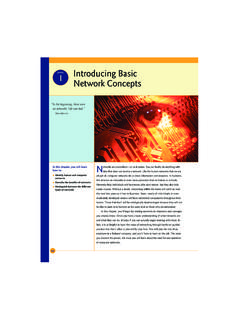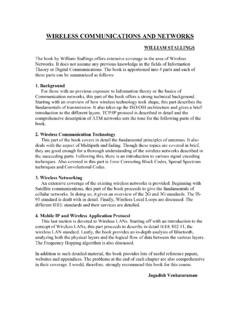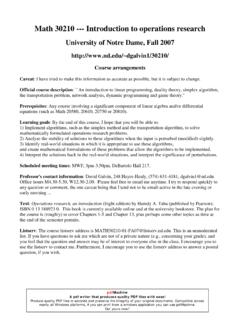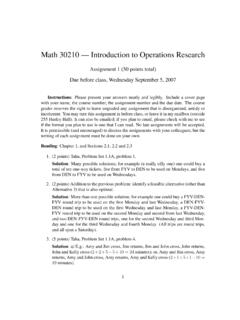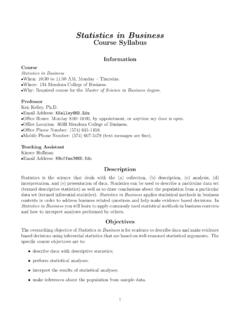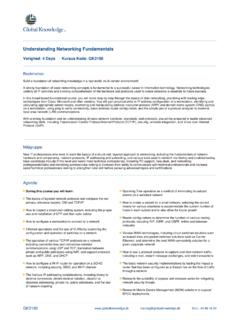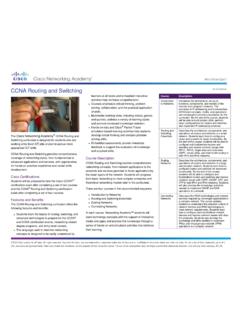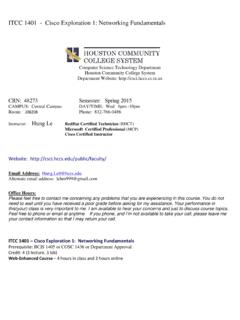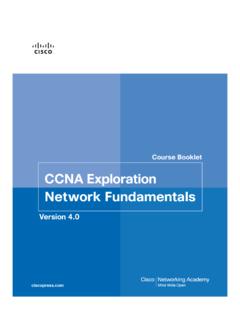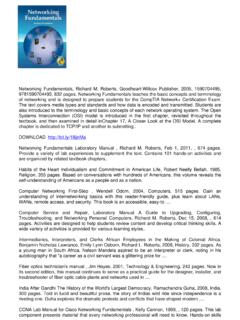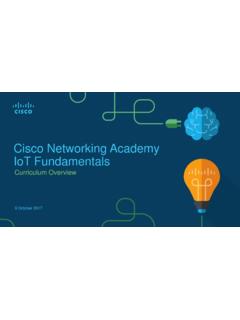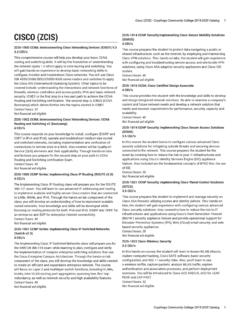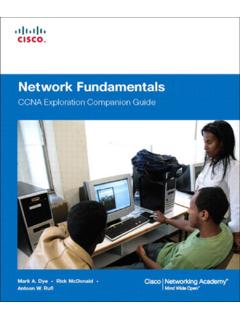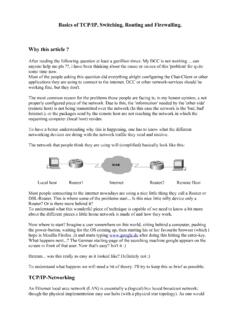Transcription of BaseTech 1 Introducing Basic Network Concepts
1 1 Introducing BasicNetwork Concepts In the beginning, there wereno networks. Life was bad. MIKEMEYERSIn this chapter, you will learnhow to: Identify human and computernetworks Describe the benefits of networks Distinguish between the differenttypes of networksxivBaseTech/ networking Concepts / team / 223089-4 / Blind Folio0 Networks are everywhere or so it seems. You can hardly do anything withdata that does not involve a Network . Like the human networks that we areall part of, computer networks let us share information and resources.
2 In business,the reliance on networks is even more pervasive than in homes or help individuals and businesses alike save money, but they also helpcreate income. Without a doubt, networking within the home will catch on overthe next few years as it has in business. Soon, nearly all individuals in evenmoderately developed nations will have networked components throughout theirhomes. Those that don t will benetologicallydisadvantaged because they will notbe able to learn or to function at the same level as those who are this chapter, you ll begin by relating networks to situations and conceptsyou already know.
3 Once you have a Basic understanding of what networks areand what they can do, it helps if you can actually begin working with them. Infact, it is so helpful to learn the ropes of networking through hands-on guidedpractice that that s what is planned for you here. You will play the role of anemployee in a fictional company, and you ll have to learn on the job. The moreyoubecomethe person, the more you will learn about the need for and operationof computer :\010 Comp\ BaseTech \089-4\ch01\ , June 02, 2003 3:12:13 PMColor profile.
4 Generic CMYK printer profileComposite Default screen Understanding NetworksAlthough you are probably taking this class to learn about computer net-works, and some of you probably already know how important networksare to businesses that want to survive, we will begin this discussion asthough you are an employee in a netologically disadvantaged (my term forthose who have minimal Network awareness) company. You might actuallybe an employee working for such a company and trying to help it out of thatpredicament, or you may know of people or companies that are in this sortof has recently been hired as the computer manager for SinkRSwimPools.
5 Lauren is a certified networking administrator, but her new companyunfortunately has only outdated computers. The owner recognized that thecompany s lack of growth was directly tied to the employees lack of com-puter skills, so in her first meeting after being hired, Lauren was given theauthority to purchase the additional computers and create the Network shehad proposed to the owner in her initial job interview. The owner gave her asix-month timeline in which to implement networking at SinkRSwim Poolsin such a way that the workers will understand its use and welcome the newknowledge it requires.
6 She was also informed that the thought of learningnew computer skills frightened some long-term SinkRSwim Pools owner expects Lauren to help them become more at ease withthe computers so they will be more likely to learn the necessary s first goal is to ease the workers fears by teaching them aboutcomputers and showing them how a need for networks develops knows that if her fellow employees understand the concept of net-working, the computer Network will more likely be successful in the has decided to review Basic Network Concepts with her coworkers asshe works with them on their new NetworksIn its broadest sense, anetworkconsists of two or more entities, or objects,sharing resources and information.
7 Although this book is about computernetworks, there are networks that don t involve computers, and thosenetworks areeverywhere. You have grown accustomed to working withthem, possibly without even knowing may not matter to you that, in a Basic sense, sharing (giving or getting)is a fundamental aspect of networking . You just know that you do NetworkMost people belong to a family Network in which related people share theirresources and information. This sharing is bi-directional because even theyoungest family members share information of some sort.
8 As the familygrows, so does the NetworkOutside the family, there is a community that offers a wider array of re-sources than the typical family can provide. Naturally, it makes sense toChapter 1: Introducing Basic Network Concepts1 BaseTech / networking Concepts / team / 223089-4 / Blind Folio1 A Network connects members of afamily :\010 Comp\ BaseTech \089-4\ch01\ , June 02, 2003 3:12:13 PMColor profile: Generic CMYK printer profileComposite Default screenconnect the family to this community to take advantage of the wealth of re-sources available around town.
9 This type of information/resource sharingcan be as simple as loaning a hammer to a neighbor, car-pooling with workassociates, or helping a friend with his or her homework. All of these activi-ties involve sharing, or trading, resources. This kind of Network is repre-sented by a two-way relationship, a give and take among equals or Network : The Client and the ServerSo, in any type of human Network , there s a lot of giving and taking. You realready more accustomed to the client/server perspective in networkingthan you realize.
10 For instance, when you go to dinner at a restaurant, you be-come a customer, orclient, enjoying the food and drink prepared and servedto you by the restaurant. On the other hand, the waiter works as aserver,controlling and providing his customers with access to resources in the formof placing orders for and delivering food items. The server knows that re-quests will be made of him (access is sought when an order is placed) andthat he will service those making the requests (access is granted when theorder is delivered).
